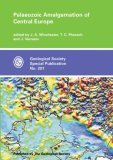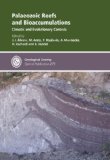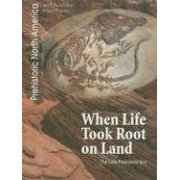
|
The Great Paleozoic Crisis
A major stimulus to research on Permo-Triassic extinctions. Erwin has done an excellent job of assembling a vast and difficult literature, and has performed a major service by focusing attention on unresolved problems and promising hypotheses. . . . Should fuel many graduate seminars, bring teachers up to date, and move research in productive directions. |

|
Palaeozoic Amalgamation of Central Europe (Geological Society Special Publication, No. 201)
Palaeozoic Amalgamation of Central Europe summarizes recent research designed to clarify the timing, geometry and processes by which discrete terranes of Central Europe became amalgamated during the Palaeozoic Era. The area studied extends from the southern North Sea to Central Poland along the Trans-European Suture Zone, covering much of Germany, Denmark, Belgium, the Czech Republic and Poland. The 15 papers within the volume are divided into five sections: biostratigraphic/provenance evidence; isotopic constraints; petrological and geochemical evidence; structural evolution; seismic traverses and deep crustal structure. The first section contains papers summarizing continent-specific micropalaeontological and sediment provenance information backing current debates about microcontinent derivation and timing of their accretions to the proto-European continent, Baltica. The section on isotopic constraints discusses the use of isotopic dating to constrain the timing of accretions of rock units exposed in the northern Bohemian Massif, while the following section has more detailed studies of metamorphosed ophiolitic complexes adjoining palaeosutures in the same area. |

|
Early Palaeozoic Peri-Gondwana Terranes: New Insights from Tectonics and Biogeography
Following the late Neoproterozoic - early Cambrian breakup of the supercontinent Rodinia, Gondwana evolved as one of the principal continental masses on Earth, embracing most of South America, Africa, Australasia, Antarctica, much of western Europe and parts of Asia. Around its margins were various other terranes that had varying tectonic and biogeographical affinities with the main continental block. This book incorporates a series of reviews and multidisciplinary research papers that together explore the tectonic, palaeogeographical and palaeobiogeographical evolution of the elements that made up the peri-Gondwanan collage. The stratigraphical scope of the coverage embraces the late Precambrian through early Devonian, providing a comprehensive overview of structural, stratigraphical and biological evolution through this significant interval of Earth history. Integration of these various processes throughout the volume will be of broad-based interest to a wide range of geoscientists. |

|
Early Paleozoic orogenesis in the Maine-Quebec Appalachians (Maine, Quebec)
Accretionary orogens, such as the Appalachian orogen, form by episodic docking of oceanic and continental fragments. Two factors that exert significant control on the development of an accretionary orogen are: (1) the nature and source of the accreting fragments, and (2) the thermal and deformational structure of the crust. This study addresses aspects of both of these controls. In the Northern Appalachians, a long-lived but untested hypothesis suggested that Early Paleozoic accretion in western Maine, which marked the initiation of Appalachian development, involved the docking of an island arc. My goal was to test this hypothesis for the Maine-Québec segment of the orogen, where the Boundary Mountains terrane had been identified as a possible collider. Combining the techniques of mapping, structural analysis, petrography, U-Pb zircon and monazite geochronology, geochemistry, and geochemical modeling, I present the following interpretations related to the geologic history of the region. (1) the Chain Lakes massif, which cores the Boundary Mountains, was an Ordovician arc-marginal basin receiving sediments eroded from a Laurentian source. (2) Anatexis of the Chain Lakes massif disrupted the original sedimentary-volcanic sequence. (3) The Boil Mountain Complex and Jim Pond Formation, which lie along the southern margin of the Chain Lakes massif, do not represent an ophiolite, as previously thought. (4) The Boundary Mountains represent a Laurentian-derived microcontinent that served as the nucleus for part of a regional arc system that collided with Laurentia in the Ordovician. The thermal and deformational processes described herein relate, respectively, to anatexis and pluton emplacement. Review and numerical modeling of the causes of low-pressure anatexis, which affected the Chain Lakes massif, indicate that appropriate pressure-temperature conditions are possible in regions of crustal-scale detachment faulting, percolative magma flow, or where thin lithosphere is accompanied by plutonic activity. Analytical kinematic modeling of the consequences of dike-fed pluton emplacement suggests that if published physical properties of granitic magmas are correct, host rocks surrounding an in-situ expanding pluton must deform at rates several orders of magnitude faster than typical tectonic strain rates. Such strain rates almost certainly must be accommodated by processes other than dislocation creep. |

|
Palaeozoic Reefs and Bioaccumulations: Climatic and Evolutionary Controls
The geological record contains a fascinating diversity of reefs and shell accumulations. As with many other biosedimentary structures, their facies characterization requires careful observation at outcrop and sample scale, and in thin-section to provide information about the global geometries, fabrics and textures respectively. This collection of papers encompasses the breadth of sedimentary geometries and facies displayed by Palaeozoic reefs, shell accumulations, and transitional composite deposits. The definition of reefs and shell concentrations has given rise to variations in nomenclature. The papers in this volume cover specific problems regarding the nomenclature and facies characterization of reefs, shell accumulations and transitional composite deposits. However, rather than attempt a complete revision of terms, the authors have touched on some of the important issues at this stage of development in the field: the main climatic, environmental and evolutionary factors that controlled the Palaeozoic development of shell accumulations and reefs. |

|
Plate Reconstruction from Paleozoic Paleomagnetism |

|
Palaeozoic Vertebrate Biostratigraphy and Biogeography
This book offers the first detailed treatment of palaeozoic vertebrates for use in correlations and in biogeographic studies. With thirteen chapters of systematic analysis of biostratigraphic and biogeographic data, it includes invaluable summaries of current research as well as new and significant contributions to the fields of geology and evolutionary biology. With charts and figures that show many of the important fossils discussed in the text, as well as stratigraphic, location, and taxonomic indexes, the book will interest palaeontologists, stratigraphers, and other earth scientists concerned with the early history of life on earth. |

|
Palaeozoic Palaeogeography and Biogeography (Geological Society Memoir Series, 12) |

|
When Life Took Root on Land: The Late Paleozoic Era
|

|
When Bugs Were Big, Plants Were Strange, and Tetrapods Stalked the Earth: A Cartoon Prehistory of Life before Dinosaurs
Grade 3-6--Bonner takes a lighthearted approach to a fascinating topic. The Carboniferous and Permian periods spanned 100 million years or so just before the better-known Mesozoic Era. The author describes many of the unusual plant and animal species from those times in a lively, conversational style. Cartoon illustrations decorate every page. Some of them are strictly informational, but most contain elements of humor as well. The facts and the fun work well together, and it's always clear which is which. In one three-panel strip, for example, two scientists offer legitimate theories regarding possible uses of a shark's (Akmonistion) spiny "turret," while a chef wishes that he could have used that unusual appendage as a cheese grater. Weather reports by well-dressed reptile ancestors, want ads for bug-eating amniotes, and pictures with word balloons are among the other comic features. The more straightforward drawings of the unusual creatures are clear and eye-catching, though not all include estimated size. A useful two-page illustrated time line gives a nice overview. Most of the species details are basic, with more emphasis on how life in general evolved during this time period. Readers also see how climate, geology, and other animals effected development. Most dinosaur books include just a page or two of pre-Triassic information, so this title offers valuable subject coverage in an appealing package.--Steven Engelfried, Beaverton City Library |






















